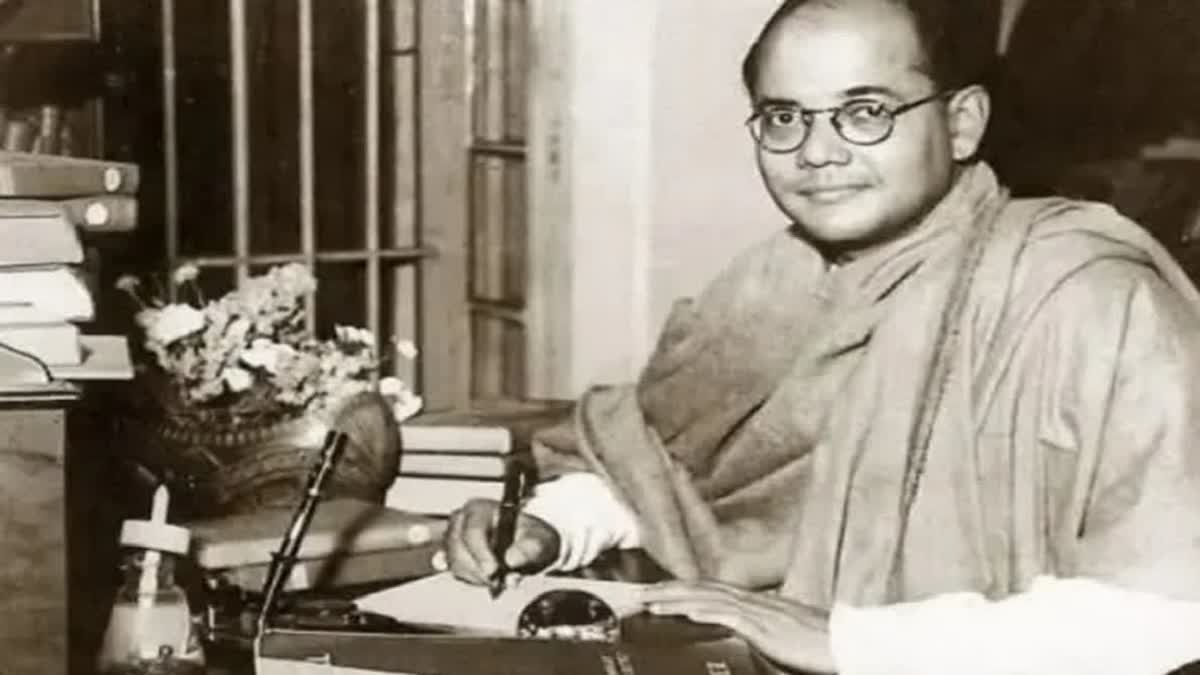By Saurabh Shukla
New Delhi: It's been years since Netaji Subhas Chandra Bose's death, and close to 10 years since the declassification of documents related to him, yet the mystery continues.
Chandrachur Ghose, an author and founding member of Mission Netaji, told ETV Bharat that it is the right time for the current government to release files related to intelligence agencies in India and abroad that were keeping an eye on him and followed different theories related to him.
“The government should accept the Mukherjee Commission report on Netaji, which was presented to the UPA government but was rejected by false facts,” he said. Ghose demanded that the government should start a fresh inquiry on the matter and lead it to a conclusive end.
‘The Bose Deception: Declassified’
In his latest book, ‘The Bose Deception: Declassified,’ published by Penguin, Ghose writes that in September 2005, the Mukherjee Commission report was handed over to then Home Minister Shivraj Patil.
From the time the report was handed over to the home minister, the rules governing the handling of top-secret were enforced in a meeting with joint secretaries in March 2006. Home Secretary V K Duggal emphasised that precautions should be taken to maintain secrecy at the time of the printing of the Justice Mukherjee Commission's report and till it is laid in the Parliament.
Secrecy of Printing of Report
Files declassified by the Narendra Modi government unravel the intricacies of how that secrecy was maintained. Three printing presses in Okhla, New Delhi, were shortlisted for printing the report, as doing it in-house was not an option. The home ministry's security division officials found that the first press they visited was fully automated. Making security arrangements here will be quite feasible as they have all facilities under one roof, a memorandum noted.
The second press appeared to be okay, but they have their units in separate buildings, and making security arrangements there may be a little cumbersome. The official settled for the third press. What appealed to them the most was that the press owner had a CCTV installed at his table so he could keep an eye on the workers who were to carry out a printing job of a secret nature.
In a letter, the owner of the printing press was born as the matter is top secret, or precautions should be taken to prevent any leakage at your end, as written in the book.
Mukherjee Report Findings
Ghose stated that from 1946 to 2006, the governments tried to suppress the truth, and this has been proven through various government documents, with all the details presented in the book. He added that the UPA cabinet was misled by the then-home minister. Regarding the rejection of the Mukherjee Commission report, a cabinet note was prepared, and this note was filled with incorrect facts. We have gone through the cabinet note and revealed the truth about what happened to the report and how the then-government lied.
The Mukherjee Commission was tasked with answering questions related to Netaji’s death, such as whether he was alive, whether the ashes in the Renkoji temple belonged to him, whether he died in a plane crash, and if he didn’t die in a plane crash, what happened to him.
Justice Mukherjee’s Commission report found that the probability of Netaji being alive in a normal biological sense was very low. He categorically stated that Netaji did not die in a plane crash, and the ashes in Renkoji Temple in Tokyo do not belong to him. As for the final question, he could not answer it due to the government’s lack of cooperation and the unavailability of relevant documents. Ghose added that the then government wrongly rejected the report and, ideally, should have given Justice Mukherjee more time.
Declassification of Files
The official website of the National Archives of India suggests that the Prime Minister of India met a delegation of members of the Netaji family at his residence in New Delhi on 14 October 2015. The first lot of 33 files that were declassified was handed over by the Prime Minister's Office (PMO) to the National Archives of India on 4 December 2015.
PM Modi also requested on October 14, 2015, on the social media platform X, that foreign governments declassify files on Netaji available to them; however, nothing much has been achieved with this exercise but a small revelation about the Mukherjee Commission report.
NDA's Stand on Netaji
A decade after the UPA government declared that the official stand had been reverted to accepting Bose's death in Taipei in 1945, Minister of State for Home Affairs Kiren Rijiju remarked in the course of a discussion in the Lok Sabha that we are not in a position to say actually what had happened to Netaji.
The statement created a curious situation. While the current government continues to hold the same position as the previous government, its ministers speak in a different voice. Following the public uproar over the government's statement that it holds that Bose died in the plane crash in 1945, an explanation was provided by the spokesperson of the Minister of Home Affairs, who posted on X on June 2, 2017, that the official stand was based on a May 2016 cabinet decision and that any other critical input would be examined.
Thus we are in a situation where the government accepts something as a fact but claims to be open to revisiting its stand if new information emerges, Ghose writes in his book.
Path to Solving the Mystery
He also suggested that the current government should reopen the case by first accepting the Mukherjee Commission report. The entire case should be revisited, especially with the many new inputs that have come to light, including declassified documents. The government should also declassify both central and state intelligence commission reports.
Read More



